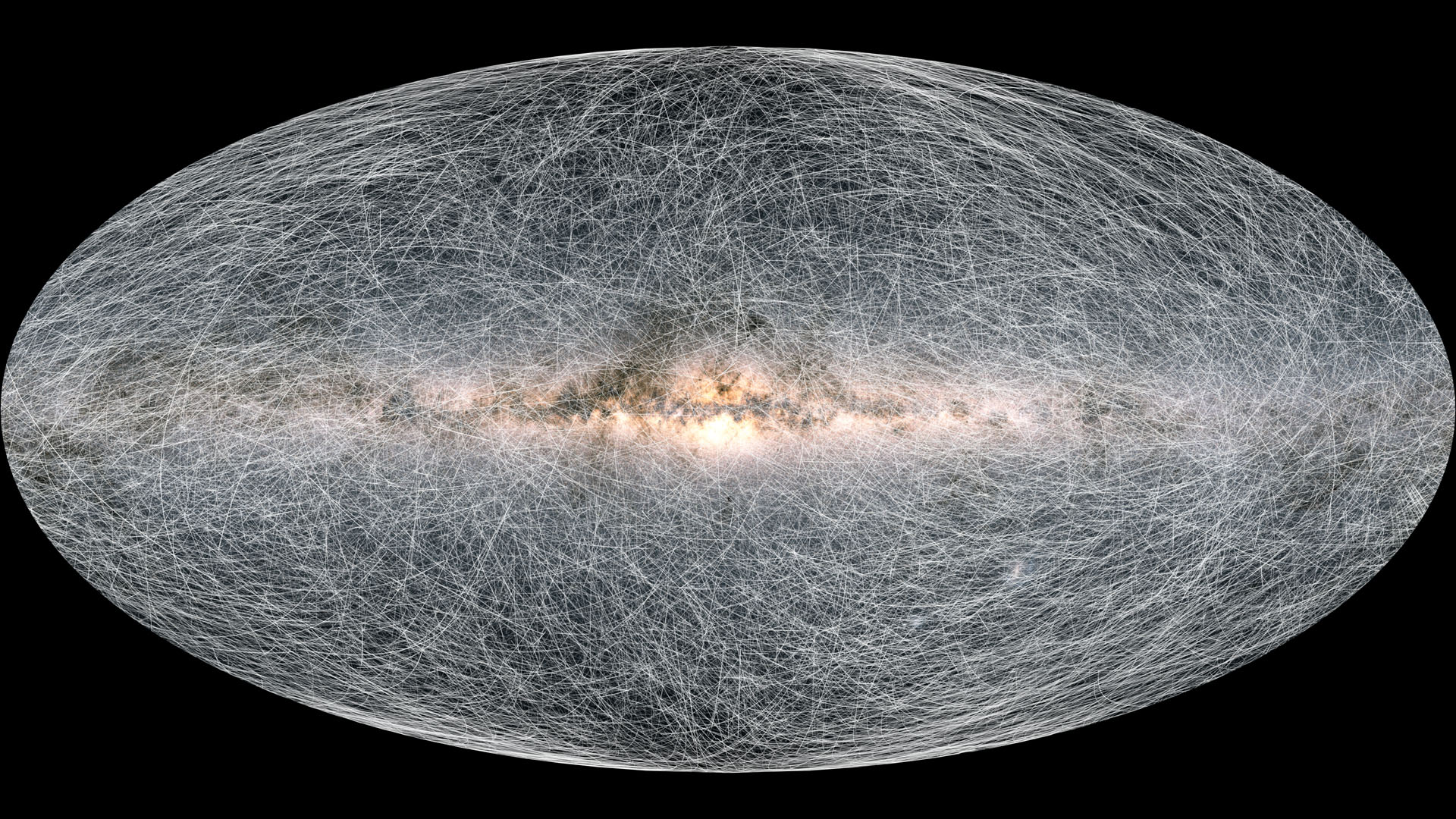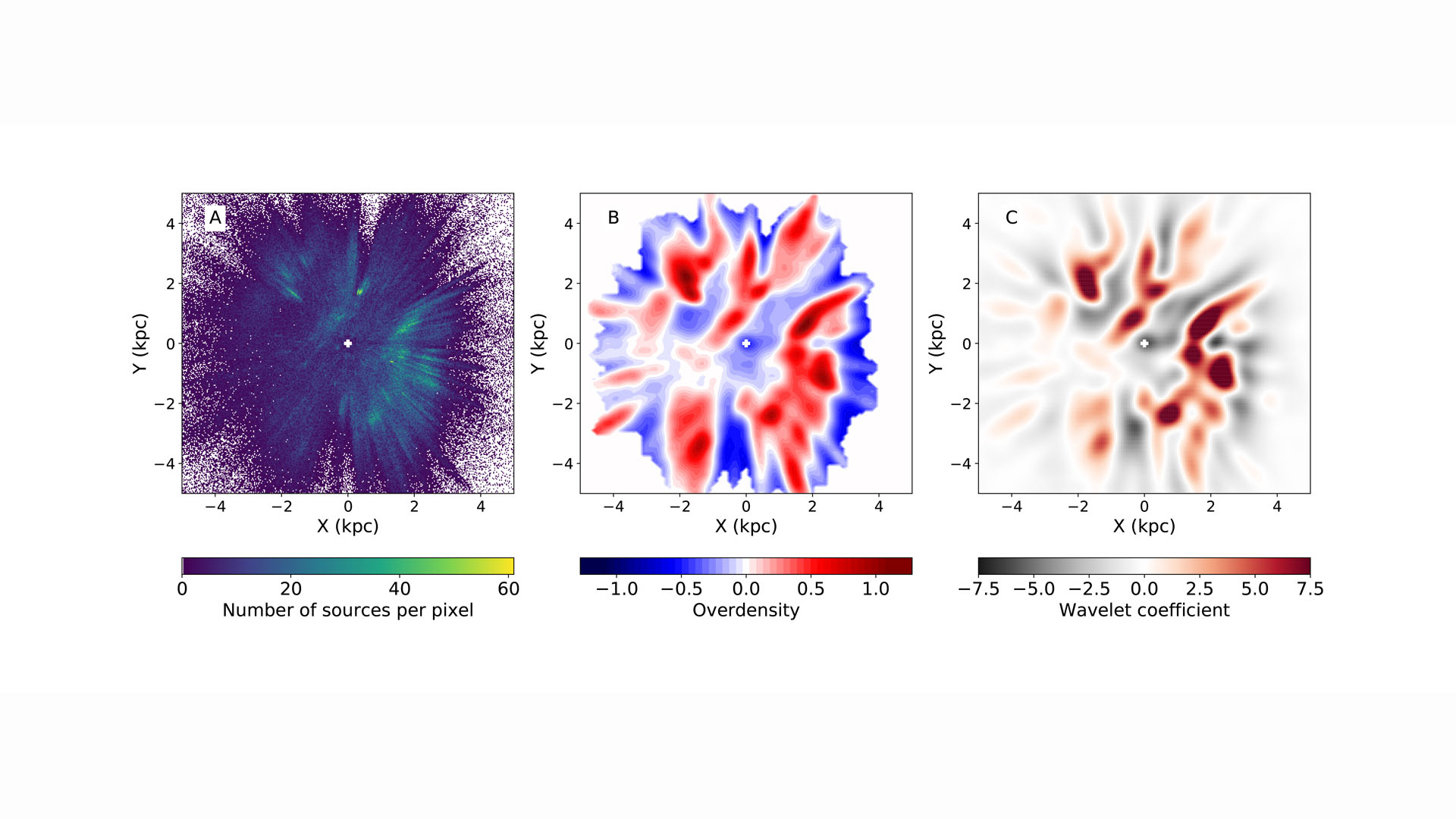Why does the Milky Way have spiral arms? New Gaia data are helping solve the puzzle
The European Gaia mission keeps uncovering the mysteries of the Milky Way.

New data from the star-mapping Gaia satellite are helping scientists unlock the mystery of our Milky Way galaxy's spiral arms.
Recently published studies exploring the Early Data Release 3 (EDR3), a batch of observations made available to the scientific community last December, reveal the spiral structure of our galaxy with a greater precision and detail than was possible before.
Since the 1950s, astronomers have known that our galaxy, the Milky Way, looks like a spiral, with several dense streams of stars and dust emanating from the galactic center, winding through the galactic disc and dissolving around its edges. However, scientists have struggled to understand how many of these streams there are and what created them.
"The problem with our galaxy is that we are inside its disc and therefore it's very difficult to understand the structure as a whole," Eleonora Zari, a scientist at the Max Planck Institute for Astronomy in Heidelberg, Germany, and author of one of the new papers, told Space.com. "It's like being in a forest and looking around. At some point, the trees are in front of each other. Plus the forest is a bit foggy, so you really can’t see what the whole forest looks like."
Related: See a virtual Milky Way map from Europe's Gaia spacecraft
The European Space Agency's (ESA) Gaia mission has been mapping the Milky Way since 2014, measuring the precise positions and distances from Earth of nearly two billion stars. The first two batches of data acquired by the spacecraft, which were released to the scientific community in 2016 and 2018, have revolutionized the study of our galaxy. In addition to the fixed positions, the spacecraft also measures how fast stars move in three-dimensional space, allowing astronomers to model the evolution of the Milky Way in the past as well as into the future.
The latest data release, EDR3, improves the accuracy of the previous data sets. And it's this precision that is enabling astronomers to disentangle the spiral arms from the rest of the stars in the galactic disc with better precision.
Breaking space news, the latest updates on rocket launches, skywatching events and more!
Where are the arms?
"We derive the distance of the stars from a measure called the parallax," Zari said. "And this parallax measurement is 20% better with the latest release. That means that stars that previously we may have seen as part of the same structure now clearly belong to different structures."
Parallax is a star's apparent movement against the background of more distant stars as Earth revolves around the sun. By measuring the change in the angle between the star and Earth from two opposite points in the planet’s orbit, astronomers can calculate the distance of the star using simple trigonometry.
In one new paper, Zari and her colleagues looked at concentrations of hot bright blue stars, called the OBA-type stars, in the Milky Way's disc. In areas where they could see a higher-than-average concentration of these stars, they could assume the existence of a spiral arm. They then compared their analysis with previously developed models of the galaxy.
"The position of the spiral arms is different and also the strength of the spiral arms, how bright they are, is different," Zari said.
The Milky Way is known to have two main spiral arms, the Perseus arm and the Scutum-Centaurus arm. Our galaxy also possesses two less pronounced arms, or spurs, called the Sagittarius and the Local Arm (which passes close to the sun).
But in Zari's study, the difference between the arms doesn't seem so obvious.
"The Perseus arm seems less bright, and instead the Local arm is more prominent," she said. "Aso the other two arms — Sagittarius and Scutum Centaurus — at least in my study, they seem to have about the same brightness."

Zari's colleague Eloisa Poggio looked at concentrations of 600,000 young stars to determine the precise position of the spiral arms. Young stars are especially valuable when studying the spiral arms, Poggio explained, because spiral arms, with their dense concentration of dust and gas, are believed to be where the majority of stars form.
"We calculated, for each position in the disc, whether that region was more or less populated with respect to the average," Poggio told Space.com. "Using that approach, we were able to construct a map of the spiral arms in the region that Gaia maps, that is about 16,000 light-years around the sun."
When the researchers compared their galaxy map to previous models, they found that the Perseus arm, one of the two dominant arms, lies further away from the center of the galaxy in the studied region. The short Local arm appeared much longer than the previous models expected.

How do the arms form?
Astronomers are also still speculating about the origin of those arms and their longevity. Some earlier theories proposed that the shape of the arms is somehow fixed and spins around the galactic center over a long period of time while individual stars, orbiting at their own velocities, move in and out of this shape.
This so-called density wave theory, however, is being disputed by the latest findings enabled by the Gaia mission. Many scientists now think that the spiral arms might not be fixed at all. Instead, they might form temporarily, as a result of the rotation of the galactic disc, and later dissolve and reform again in a different configuration.
To find which theory is correct, Alfred Castro, of the University of Leiden, in the Netherlands, looked at so-called open clusters, groups of thousands of young stars born from the same cloud of gas and dust. Due to their young age, these stars are still close to their birth place, that is within the spiral arms. If the newer theories were correct, the amount of younger open clusters in the spiral arms would be higher than the amount of older open clusters, Castro speculated. And that's exactly what the data showed.
"I saw in the data that the spiral structure appears to contain the younger population of stars but disappears if you look at the older stars," Castro told Space.com. "We see that the rotation rate of the shape is more or less similar to the rotation rate of the stars and varies with the radius to the galactic center. The shape and the stars can't be decoupled, and that means we don't have a global shape, which would be the spiral arms, and then the stars moving in and out of them as the density wave theory suggests."
According to Castro's analysis, the spiral arms may exist for about 80 to 100 million years, a small fraction of time in the 13-billion-year life of our galaxy.
What gave the Milky Way the spiral arms?
In the future, Poggio hopes, scientists might be able to find out why those spiral arms in the Milky Way exist in the first place. While some theories expect this swirl of stellar streams may have been born after another, smaller galaxy crashed into the Milky Way, others believe it came to existence naturally as a result of the rotation of the galactic disc.
"We expect that we would see different signatures in the motion of the stars if the spiral arms were caused by an external impact," Poggio said. "Future Gaia data releases will give us more information about the motion of stars in a greater portion of the galactic disc, and we hope we might be able to find something there."
The next batch of Gaia data, the full Data Release 3, is expected to be made available to scientists worldwide in about mid-2022. Gaia, one of the most productive missions in history (measured by the number of scientific papers it produces), will continue scanning the sky until 2025. The vast catalogues of stellar positions, motions and velocities it creates will keep astronomers busy for decades to come.
The papers by Poggio, Castro and Zari were published in the journal Astronomy and Astrophysics in July.
Follow Tereza Pultarova on Twitter @TerezaPultarova. Follow us on Twitter @Spacedotcom and on Facebook.

Tereza is a London-based science and technology journalist, aspiring fiction writer and amateur gymnast. Originally from Prague, the Czech Republic, she spent the first seven years of her career working as a reporter, script-writer and presenter for various TV programmes of the Czech Public Service Television. She later took a career break to pursue further education and added a Master's in Science from the International Space University, France, to her Bachelor's in Journalism and Master's in Cultural Anthropology from Prague's Charles University. She worked as a reporter at the Engineering and Technology magazine, freelanced for a range of publications including Live Science, Space.com, Professional Engineering, Via Satellite and Space News and served as a maternity cover science editor at the European Space Agency.
